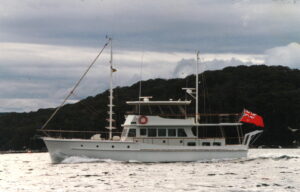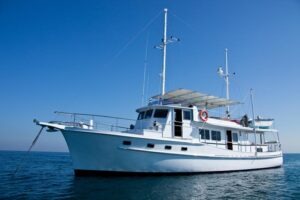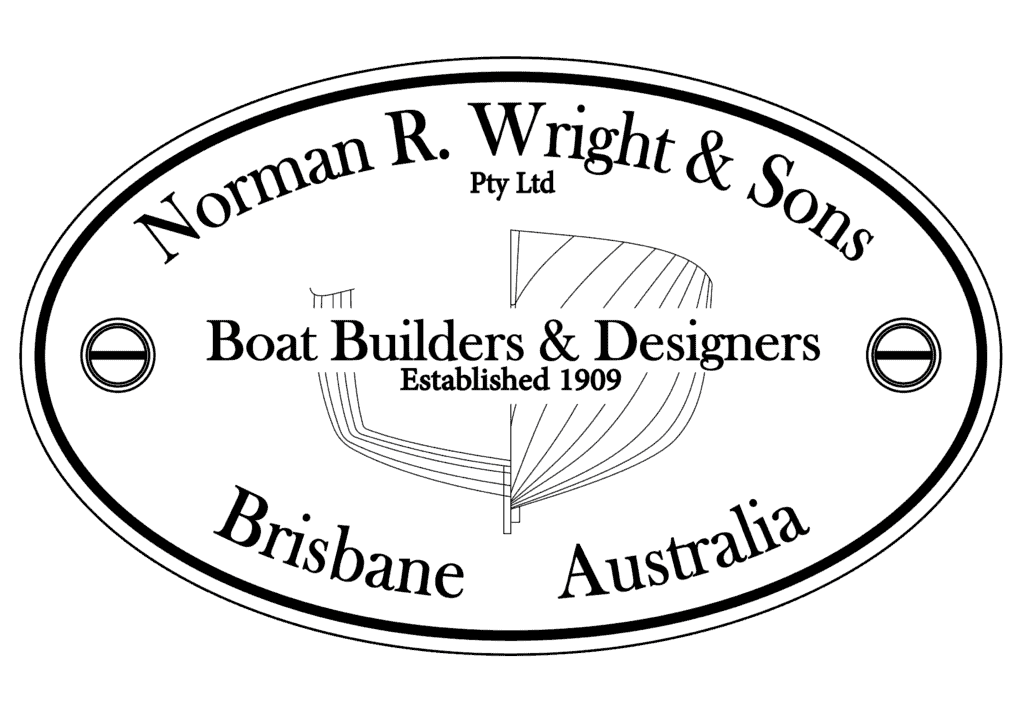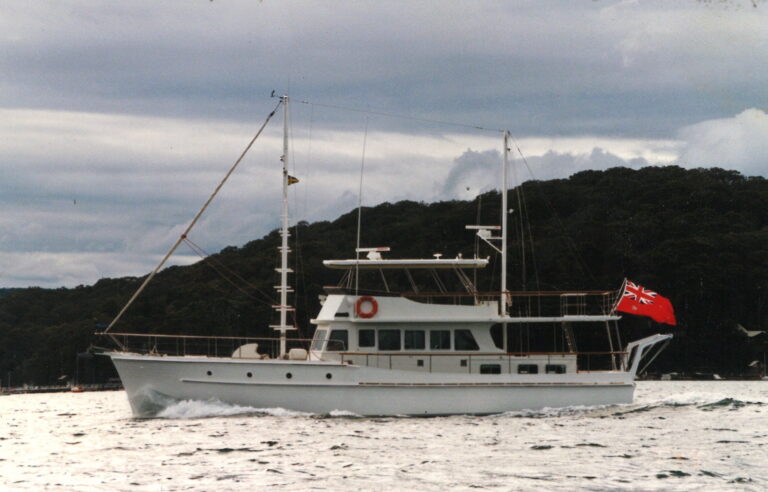Lorellen
 In 1973, we were contacted by a Mr. Denny Porter of Sydney. He wanted to talk to us about a new pleasure boat. A week later he flew up to Brisbane to discuss the details. Even though I was only a second-year apprentice at the time, Dad asked me to the drawing office (in Quay Street) to take notes from the meeting. I hiked up the steep loft stairs to the drawing office to meet Denny. I immediately warmed to this laid back, handsome middle-aged gentleman. He was the spitting image of David Niven.
In 1973, we were contacted by a Mr. Denny Porter of Sydney. He wanted to talk to us about a new pleasure boat. A week later he flew up to Brisbane to discuss the details. Even though I was only a second-year apprentice at the time, Dad asked me to the drawing office (in Quay Street) to take notes from the meeting. I hiked up the steep loft stairs to the drawing office to meet Denny. I immediately warmed to this laid back, handsome middle-aged gentleman. He was the spitting image of David Niven.
Dad and Denny talked about the requirements for this proposed vessel. Eight berths, one being an aft stateroom. Forward below deck he required two heads and showers, galley with a dinette and two twin berth cabins. The engine room was to have a Deutz six-cylinder diesel (owner supplied) and fuel enough for extensive long-range cruising. The boat to be traditionally planked, with a cruising speed of 8 ¾ – 9 knots.
Denny returned home to Sydney and Ron immediately drew up a basic profile and general arrangement plan that fulfilled his requirements. The hull was to be a length of 57’ overall, beam of 15’6” and a rough draught of 5’9”. The engine room layout was designed around the beautiful 6-cylinder, water cooled, Deutz. Ron was enormously impressed by this engine. He called it the German Gardner. It was, and still is to this day, a beautifully built and engineered diesel engine. The Deutz F6M179 had 152HP at 1650 RPM. Ron said the new vessel would achieve 9.5 knots. It was a continuously rated engine so it could be run at maximum revs 24hrs a day. Ron completed a lines plan which was very similar to, but a larger version of two previous vessels – the Idle Hour and Rigil Kent. The lines Ron drew were a bit rough as his drawing skills had not fully returned from the car accident in 1966. Ron then completed the pricing exercise, no excel spreadsheets in those days, just a big foolscap book where every component of the vessel was noted and priced.
Denny received the pricing and agreed to progress to building the boat. A contract was signed, and we were underway. Ron’s next job was to do a detailed weight analysis. Again, the trusty foolscap book was used. Every component in the boat was given a weight and a centroid, then at the finish of the exercise, all items were added up a to provide a lightship weight as well as a longitudinal centre of gravity and a vertical centre of gravity. From this Ron could determine where the waterline of the vessel would be as well as confirming his powering predictions.
I was summoned to the drawing office and told to go up to the top loft and loft out the boat (draw it full size). This was only my second lofting job, so I was pretty nervous. I set to the task and had the lofting completed 5 days later – a job I really enjoyed.
On completion of the lofting, the moulds and patterns were made up in the loft. While these items were being constructed, the Iron Bark keel had been sourced from Kyogle by our boatyard manager Bill Anderson. While there, Bill also sourced the Spotted Gum stem, deadwoods and steam bent timbers, and the planking for the bottom (which was also Spotted Gum) and the stringers (which were cut from Yellow Wood, also known as Mountain Ash). The yard was a hive of activity. We only had about 15 people in those days, so we were all very busy setting up the new 57-footer as well as looking after all the slipway work which again was very busy. In that era, we had 4 slipways which were always fully booked.
The 57‘ vessel was quickly setup and faired. The garboards and sheer planks fitted and then the two planking teams (one either side) planked the vessels. Planking, while hard work, was a lot of fun. I was paired with 70-year-old George Franz who had worked for my grandfather, uncle and father. He was a hard man but had a great sense of humour. Unfortunately, I cannot remember who planked the other side. Lenny Spring, who was two years’ younger than George, was spiling the planks. Unbelievably he did most of this by rough measurement and eye. Lenny had been with Norman Wrights since 1934. Lenny spiled almost all the Norman Wright’s boats from the late 1950’s until the late 1970’s with the exception of Dolphin II. (Dolphin II had a disappearing chine which Lenny could not get his head around. The spilling of Dolphin II was done by Donny Watson.
Up in the joinery loft, Roy Culverhouse (our leading cabinet maker) started building the furniture with a very young 2nd year apprentice Russell Moore. (Russell would later marry Roy’s daughter Patti). The furniture was made from Queensland Maple and then stained with what we called “the Mud Stain”. This staining was done prior to applying 3 coasts of satin varnish. The stain evened out the mismatch of colours that Queensland Maple can throw at you.
The boat progressed quickly. Denny and his wife Lorna were regular visitors. He was most interested in how the boat was constructed and fitted out. He never interfered with the design of the fit out or build. He was such a good bloke to build for. The Deutz engine arrived on a truck from Sydney. We offloaded it with our then dodgy gantry, the whole staff and the boys from Baddiley’s gathered around to admire the beautifully engineered and finished engine.
Burnie Smith and Fars De Jong were responsible for all the electrical design and fit out. Burnie had been working on Norman Wright boats since WWII. There was nothing that Burnie and Fars did not know about electrics. The electronic package also arrived about this time. This included a stand-alone Furuno radar with the then astonishing range of 48 miles. It also represented 4% of the total cost of the boat!
The wheelhouse was constructed on the deck of the vessel. The flybridge was made off the boat by Billy Hill. This was the first time I had witnessed a part of the superstructure not being built on the boat. The Queensland Beech decks were laid and payed in Lastromeric (like an early Sikaflex). Then the painting etc progressed to a stage where the boat was ready for launching, without rig, as the masts would not fit while in the shed.
A launching party was organised by Denny and Lorna. I knew it would be a good one as Denny loved to party. The only item missing at this stage was the name! Denny came good as always and said it would be christened “Lorellen” after his wife Lorna and daughter Hellen.
She was launched with a splash of champagne across the bows. Down the slip she went until she settled nicely floating well above her waterline. A great start to the life of a beautiful boat.
The rig, main and mizzen masts were built and fitted by Jeff Buttrose of Almasts. The rig included jib and mainsail.
Great – ready for trials! Would I get an invite from Ron like I used to when I was at school? No, missed the Lorellen trials. Apparently Lorellen completed all her trials with no hiccups. Bill Anderson said she behaved beautifully. She obtained a speed of 9.7 knots on the measured mile.
With the trials completed, Denny was itching to get the boat to Sydney to show her off to this mates at the Royal Motor Yacht Club in Pittwater. Bill Anderson asked if I wanted to crew for the delivery trip to Sydney. “Yes please!” was my answer. Bill and I were joined on the trip by Bruce Anderson (Bill’s son), Denny, and a friend of Denny’s who name I no longer remember.
We set off across the bay then out to sea over the South Passage Bar. We had a light to moderate S.E. wind the whole way to Sydney. The Qld Beech decks received plenty of clean salt water over them. They looked a treat as we entered Pittwater. It was very early in the morning, just before sunrise. I remember standing on the flybridge with Denny and Bill Anderson shivering due to the cold moist wind. Past the Barrenjoey Light and up the Pittwater we went. We docked at the RMYC to be greeted by Lorna and about 15 to 20 of Denny’s boating mates. A great trip, Lorellen went beautifully. She was a great boat for coastal cruising. I would go on to do seven more of those trips with Denny. I enjoyed them immensely.
Kala Venturer
(Photo courtesy Classic Moreton Bay Cruisers)
As we docked, on the maiden voyage, I noticed a person making his way through the crowd of well-wishers. This chap was very eager to get to the boat yet none of us knew him.
He arrived at the gangway and asked to come aboard. He introduced himself – “Hi my name is Kevin Alexander”. He was a very fit, well-tanned, bright man who was very eager to know all about Lorellen. Bill Anderson sprung into boat sales mode (well, as much of a salesman as any of us where). He showed Kevin the Lorellen from top to bottom. Kevin was very impressed and asked if there were any improvements Bill would suggest. “None!” came the answer. Kevin asked for a set of plans and a price. Bill rang Ron and asked him to update the price and to send the plans to Kevin. This happened over the next 7 days. Kevin agreed to the price and flew up to Brisbane to meet Dad and signed the contract to build the boat. He and Dad altered the forward cabin arrangement and altered the engine room arrangements to accommodate the Gardner 8LXB which Kevin required. Dad altered the lines plan slightly by giving the new hull a slightly straighter buttock line aft of the hollow heel. I was then sent up to the loft to alter the Lorellen lofting to suite the new buttock lines. The lofting completed, David Bliss, Shane Conway and myself, then made all the patterns and building moulds in the loft before transporting down the skids to the middle slip building bay area at the Quay Street shed. The vessel was then set up and planked the same way as Lorellen.
The same fit out crew were used to build the furniture for Lorellen so the new boat progressed quickly. The Gardner 8LXB caused a small delay as it had to be shipped from England. The engine arrived just in time for fitting to the engine room prior to the final construction of the superstructure. The vessel was built with removable hatches for engine installation in both the main deck of the saloon and the flybridge deck. This is also very handy when in later years the engine may have to be removed for a major refit.
Kevin and his wife were regular visitors to the Quay Street boatyard. Kevin developed a real friendship with our long-term secretary Mrs. Connors. Mrs. Conners really ran Norman Wrights. A marvellous lady who would undertake all the office jobs and more. Kevin called Mrs. Connors “Mrs 10%” after noting the handling fees on our purchases. Kevin, Mrs Connors and Dad all enjoyed each other’s company and you would often see them at 4:20pm in Mrs Connors office having a laugh in the haze of Mrs Connor’s cigarette smoke.’
Launching day was fast approaching and Mrs Connors asked Kevin, “Have you a name in mind for your new vessel?”. Kevin answered yes, “I will call her “Kala Venturer” – a combination of his and Mrs Alexander’s initials.
Kala Venturer was launched with no great fanfare or party. She was a beauty on the water. The sheerline was near perfect. We began trials and all went well. She exceeded her 10 knots with ease. Bill Anderson and Dad were totally satisfied so a date was set to travel to Sydney. Crew for this trip Bill Anderson, Kevin, Bruce Anderson and myself. We travelled our normal course. When we were off Ballina, Bruce noted during an engine room check that the stern gland was getting very hot. Bruce loosened the backing nut to let the water pass through the gland in an endeavour to cool it. This did not work. Bill decides that the only course of action was to return to Brisbane and re-align the engine. So, we about turned and re-traced our course to the Quay Street yard. Rogers and Lough, who had done the engineering on Kala were called in to re-align the engine and to double check all the other engineering componentry. With this completed, we were ready for sea once more. Bill Anderson asked me at the last moment to retention all the keel, stringer, floor and engine bed bolts. This is always a bit tricky as the bolts were all hand made from copper rod and could snap if over tensioned. Yes, I over-tensioned a keel bolt and snapped it. I was not very popular to say the least. I had to re-slip Kala, make a new keel bolt, remove the old bolt, which meant removing part of the chaffing batten and copper sheathing, then fit the new keel bolt and again refit the copper and chaffing batten. This took me and an offsider 3 days.
Ready to go again. Same crew, same course, we set off. The weather was absolutely perfect for our trip south. We continued south to Coffs Harbour with Kala performing splendidly. A lovely 15-18 knot N.E. breeze had sprung up so Bruce and I set the sails. First the jib, then the mainsail and yes even the mizzen. Our speed may have increased slightly, however the rolling was dampened with the sails pulling hard on their sheet ropes. We continued with the sails until Port Stephens and then stowed them. We arrived at RMYC at Pittwater early the next morning. Denny Porter and many other people we knew were there to greet us. What a splendid trip. We handed Kala over to Kevin. Over the next 10 years he used her regularly. Every now and then we would get a call to take her from Sydney to the Gold Coast were Kevin eventually kept her until selling her on to the next custodian.
Tringa II
 (Photo courtesy Classic Moreton Bay Cruisers)
(Photo courtesy Classic Moreton Bay Cruisers)
During the construction of Kala, one of our local clients, Gordon Harris, slipped his beautiful 1948 Norman Wright classic Dorothy T. He saw the Kala under construction and took an abnormal amount of interest in her as she slowly took shape.
Gordon then approached Ron about designing a similar vessel. Gordon’s requirements were different from Denny’s and Kevin’s designs. Gordon wanted a twin screw, pilot house vessel with the galley on the main deck, not down below like Lorellen and Kala. Gordon’s requirements also included a shallower draft and a higher cruising speed. Ron’s solution was a 57ft vessel with an increased beam of 12” over Kala and Lorellen making the new vessel 16’6” in beam. The original design draft of Lorellen was reduced to 4’8”. This was achieved by a broader transom enabling more body of the boat to counter the reduction in draft. The buttock lines also featured a slight reverse above the twin propellers which created a flatter run aft. Ron gave me the rough lines plan and asked me to loft the vessel. As I was lofting her, I realised that there was a considerable difference between her lines and Lorellen’s. I could see that she had the potential of more speed just by looking at the buttock run aft. She had a beautiful sheerline like Kala and retained the full keel and tight hollow heel of Lorellen. The full keel was a definite requirement of Gordon’s as he said he used to run aground regularly in the Dorothy T. I could see she was going to be a more difficult boat to spile and plank. “No problem” to the old boys of the shed, as I asked the question raising my concerns.
Again the normal processes then followed with making the moulds and patterns, setting them up on the keel and deadwoods, putting the clamps and ribbands around the moulds, fairing up ready for the seam bent timbers. Once timbered, a quick fair and then on with the planking. Like Lorellen and Kala, she had Spotted Gum bottom and Douglas Fir topsides. When planking, it was always a relief when you finally got to the Douglas Fir planks, they were so light and easy to handle compared to the Spotted Gum planks.
The fit out team of Roy Culverhouse and Russel Moore started building the furniture. At this stage, Gordon became heavily involved. He wanted to know all about the fit out. He would sketch up how he wanted things done. During the building of the flybridge, he stood at the helm of the flybridge and could not see the anchor so he asked us to cut a wedge out of the wheelhouse sides in order to lower the wheelhouse deck. This was done, however the headroom in the wheelhouse became minimal. This involvement with all details remained until the vessel was delivered.
The engine room was fitted with two Detroit 4/71 diesels. The engine room felt a lot roomier than Kala and Lorellen which I attribute to the one foot of additional beam.
With the fit out and painting completed, we moved her off her building stocks and onto the slipway for launching. Prior to launching, her twin masts were fitted.
She looked like a handsome boat on launching day. The Ron Wright hull design looked beautiful from all angles.
After launching the trials were conducted and she performed very well. Her maximum speed was 11 plus knots allowing her to cruise at a respectable 9.5knots.
Gordon named the boat “Tringa II”. He spent the next 26 years cruising Tringa II up and down the Queensland coast and Moreton Bay. He only sold her when he was well into his 80’s.
Postscript
Lorellen is now owned by Douglas Quayle. He is the third owner of Lorellen. He has worked hard to bring her back to her former glory and will be a wonderful custodian of this fine vessel.
Kala Venturer passed through a number of owners – Robert Lane of Melbourne, John Hughes, the Wilson Family, Bruce and Nikki Phillips, and is now owned by John Kennedy. John keeps Kala in top condition and uses her extensively for cruising from his Hobart base to the Great Barrier Reef on a regular basis – and often stopping into Wrights on the way through for some extra TLC.
Gordon sold Tringa II to Jeff Hall in 2004. He owns her to this day. Jeff refitted Tringa II with a pair of 6LXB Gardners. She is in excellent condition. Jeff is a regular on the Queensland coast and cruises Tringa II extensively as she was designed to do.
Three great boats, three interesting stories, all currently owned by three great custodians.



